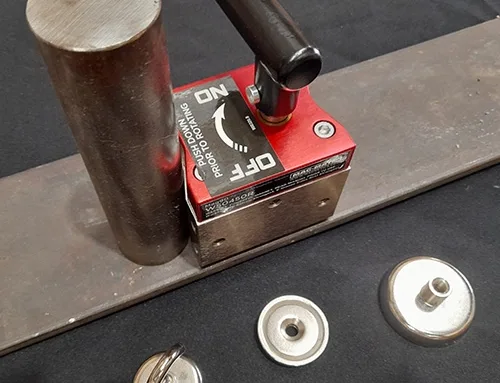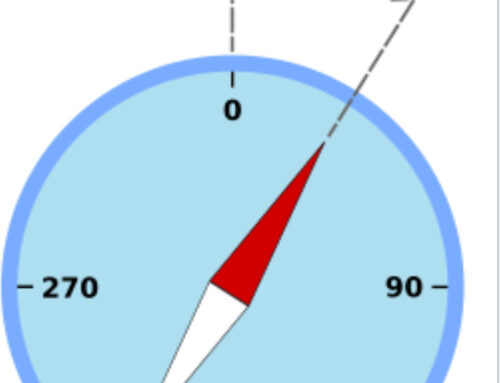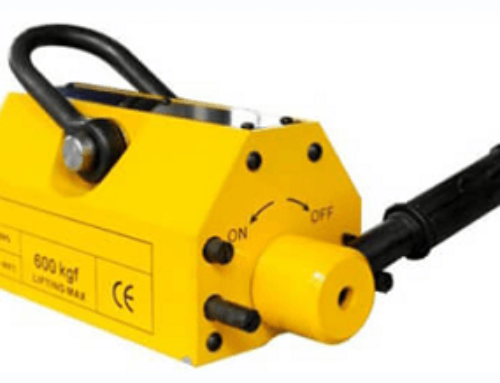How temperature affects magnet performance
When you design applications with permanent magnets, you need to know the temperature range the magnets will be exposed to. Temperature changes affect how strong the magnet is and how well it works. If you don’t understand this, you’re going to get something that doesn’t work as well as you want. So, you need to know how different magnetic materials behave with temperature.
All magnetic materials will have a change in flux density as the temperature changes. In general, magnets get stronger as the temperature goes down, except for ferrite magnets. All permanent magnets will lose some of their performance as the temperature goes up. The question is, “Do I get the performance back when it cools off?” That depends on the type of magnetic material and the maximum temperature it’s designed to operate at.
There are three types of magnetic performance loss you can experience as a result of temperature:
- Reversible Loss: This happens when the temperature of the magnet goes up above ambient, but it doesn’t go above its maximum temperature rating. When the magnet cools off, you get all of your performance back.
- Irreversible Loss: When the magnet goes above its maximum temperature rating but doesn’t go above its Curie temperature, you lose a little bit of performance. When it cools off, you get some of the performance back, but you never get all of it back unless you re-magnetize the magnet, which is usually not cost-effective.
- Permanent Loss: When the magnet goes above its Curie temperature, the magnetic domains in the magnet change structure, and that damage is permanent. You can’t recover that performance by re-magnetizing the magnet.
While magnet datasheets often include the Curie temperature, it’s not a useful number for practical design. You shouldn’t operate anywhere near the Curie temperature. You need to know the maximum operating temperature.
How does temperature affect Neodymium Magnets
Neodymium magnets are known for their high magnetic strength at room temperature. If you heat them up, their performance goes down, even if you don’t get them up to their maximum temperature. For every degree Celsius increase in temperature above ambient, you lose between 0.08% and 0.12% of the strength of the magnet.
Standard neodymium magnets have a maximum temperature rating of 80°C. There are high-temperature grades that you can use up to 150°C, but above that, you’re better off using a samarium cobalt magnet because it will have more strength. If you get below -138°C, the magnetism in the neodymium magnet changes, and you lose 10% to 20% of the magnet’s performance.
How does temperature affect Samarium Cobalt Magnets
Samarium cobalt magnets are not as strong as neodymium magnets at room temperature, but they have better thermal stability. Neodymium magnets start losing a lot of strength above 150°C. Samarium cobalt magnets can handle up to 350°C before they start losing strength that you won’t recover when they cool off. That’s why you use samarium cobalt magnets in high-temperature applications where you need the thermal resistance.
How does temperature affect Alnico Magnets
Alnico magnets are the next strongest magnets after neodymium magnets. They have a high remanence and low coercivity. The downside of alnico magnets is their resistance to demagnetization. They don’t like external magnetic fields or physical shock. But alnico magnets have excellent thermal stability. For every degree Celsius increase in temperature, you lose 0.02% of the strength of the magnet. You can use alnico magnets up to 525°C (977°F) without doing permanent damage to them.
How does temperature affect Ferrite Magnets
Ferrite magnets are different from the other magnets. As the temperature goes up, their resistance to demagnetization gets better. For every degree Celsius increase, you lose 0.2% of the strength of the magnet. You can use ferrite magnets up to 180°C before they start losing strength that won’t come back. That’s why you see them used in motors and generators.
.
When you design with magnets, you need to know the temperature range the magnets will be exposed to. If you don’t understand how the magnets you’re using will respond to temperature, you will not get the performance you want.
Neodymium magnets are strong magnets, but they don’t like heat. Samarium cobalt magnets are not as strong as neodymium magnets, but they’re more stable at high temperatures. Alnico magnets can handle the heat. Ferrite magnets do well with high temperatures, and as they get hotter, they become more resistant to demagnetization.
By understanding the environment your application will operate in and selecting the right magnetic material, you can make sure your application will work the way you want it to for a long time.Please contact us to get more magnet information.





Leave A Comment